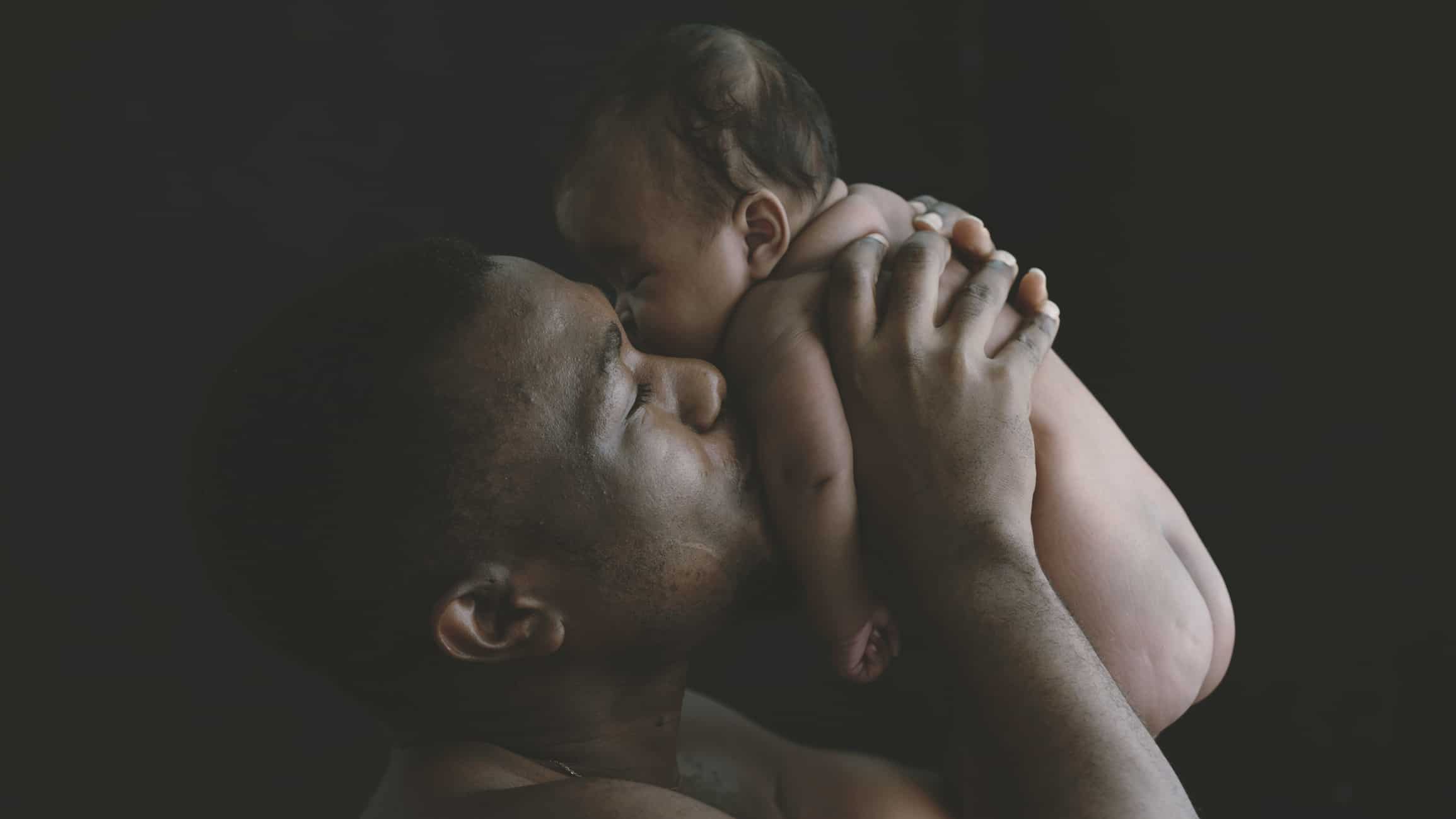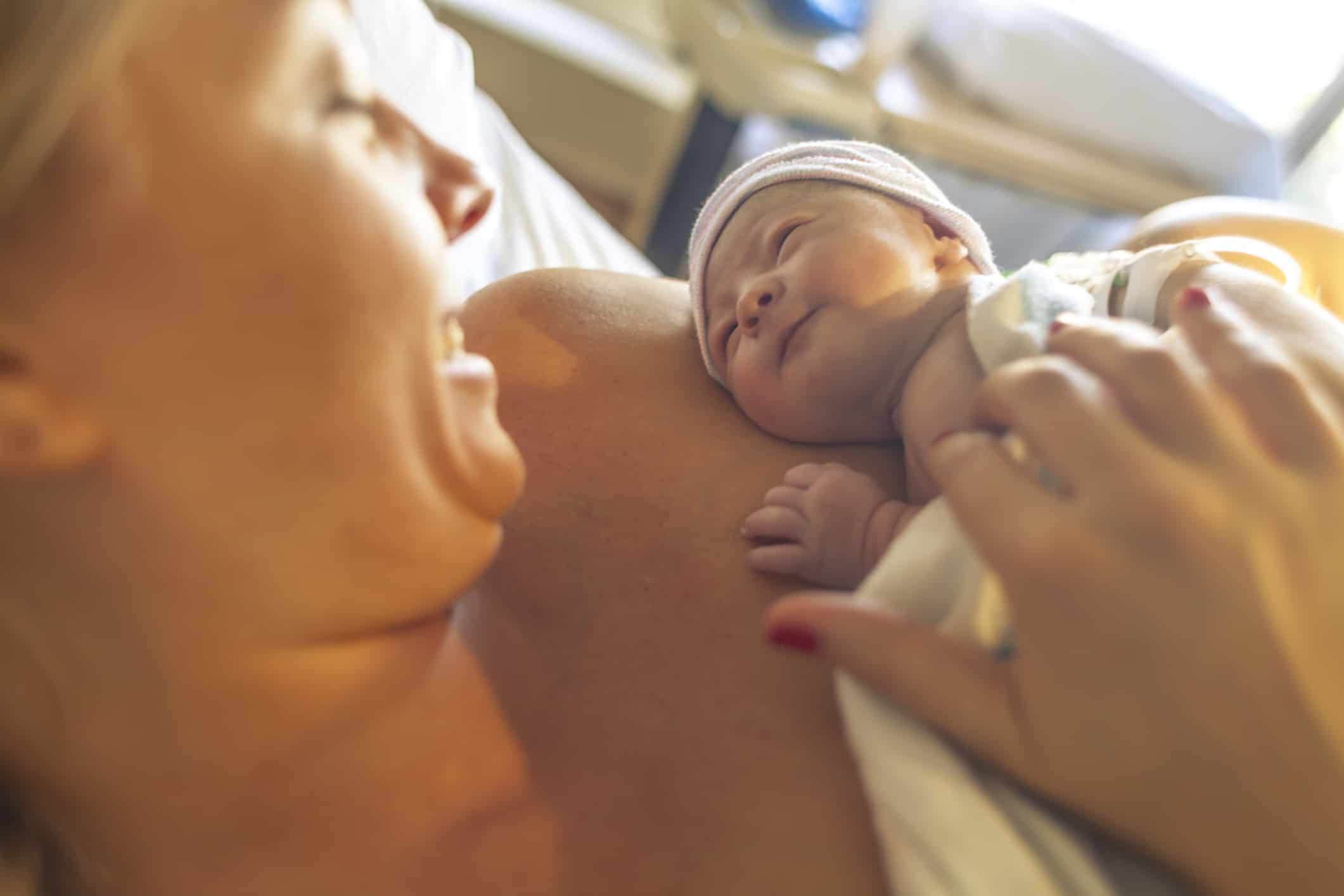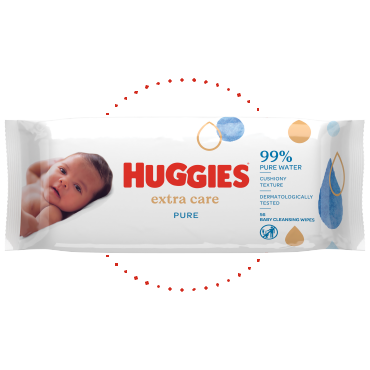Our guide to skin-to-skin contact will help you decide if this bonding method is something you might want to add to your upcoming birth plan. We’ll take you through:
- What is skin-to-skin contact with your baby?
- Benefits of skin-to-skin contact
- Can dads and partners do skin-to-skin?
- Skin-to-skin after birth
- How long should a skin-to-skin session last?
- When might I not be able to hold my baby next to the skin?
- Why you might have to wait for your first cuddle
What is skin-to-skin contact with your baby?
Skin-to-skin contact is, simply, holding your baby with their bare skin next to yours. The moment of birth is an amazing one and when your baby emerges, the first thing your midwife or obstetrician will do is to place them on your stomach or chest for the very first cuddle between you. You may also hear this referred to as Kangaroo Care, getting its name from the way skin-to-skin mirrors how mother kangaroos hold their joeys in their pouches. This term is commonly used in premature baby care methods.
You should also try to repeat skin-to-skin sessions as often as you can in the early days and months of your baby’s life. Your baby has been tucked up inside you for nine months and is used to feeling constant contact on their body, so putting them against your skin at birth helps them feel safe. Your baby can feel your warmth and smell your skin, as well as hearing your voice and heartbeat. All this combines to make a baby feel secure.

Benefits of skin-to-skin contact for you and your baby
Skin-to-skin contact has a range of benefits for both mother and baby (as well as dads, partners, or other primary caregivers!):
1. Skin-to-skin triggers a powerful hormone rush
Skin-to skin contact at birth triggers a rush of powerful hormones, including oxytocin, that help parents bond with your baby. Most research on skin-to skin contact focuses on how it supports bonding with your newborn in the first few hours, but studies show that connection continues to strengthen with further skin-to-skin cuddles.
2. Can help calm you after an intense labour
Immediate skin-to-skin contact with your newborn can help calm mothers after what might have been an intense labour and delivery. The rush of hormones not only act to build a bond, but trigger a sense of relaxation and contentment.
3. Your skin helps keep your baby’s temperature stable
Newborn babies haven’t yet developed the ability to regulate their temperature properly. Both initial and future skin-to-skin contact helps keep your baby’s body temperature stable. In fact, studies have shown that skin-to-skin contact with both parents is better than some artificial sources, such as incubators - though incubator care is still crucial for babies born prematurely in addition to physical contact..
4. Helps keep regular breathing and heartbeat
Skin-to-skin contact with your newborn can help keep your baby’s breathing regular and their heartbeat at a stable rate. After birth, babies transition drastically when they take their first breaths outside of the womb. By having the familiarity of their mother’s heart rate close, this transition can be made easier.
5. Maintains your baby’s blood sugar levels
Newborns use their blood sugar for energy. This comes in the form of glucose. Before being born they get glucose from the placenta, but once delivered into the world they have to get it from their mother’s milk, or formula. Skin-to-skin contact after birth can help them remain healthy and free from fluctuating blood sugar levels, keeping your baby free from the risk of overly low or high blood sugar.
6. Helps start feeding, stimulate the digestive system and transfer good bacteria
The initial skin-to-skin contact can help initiate your baby’s feeding instincts, which is really useful if you’ve chosen to breastfeed. It has been observed that newborns, if placed on their mother’s tummy after birth and left there undisturbed, will start to open their eyes, relax, then begin to crawl slowly to the breast and start sucking. This is called the “breast crawl.” Their heightened sense of smell and closeness to the mother will help them locate and latch on.
7. Stimulates digestion and good bacteria transfer
The initial contact and breastfeeding helps stimulate digestion and transfer much needed good bacteria to the baby’s digestive system. There are some complex sugars found in human milk which can’t be digested when first entering the world, but are essential for certain bacteria which coat the intestinal wall. These bacteria are key in a healthy functioning digestive system and provide protection from harmful bacteria.
8. Skin-to-skin contact can help deliver the placenta
The oxytocin released by mum during the post-birth skin-to-skin session helps your uterus to contract. Consequently, these contractions help deliver the placenta sooner and quicken the third stage of labour after birth.
Can dads and partners do skin-to-skin contact?
Yes, skin-to-skin contact for dads and other parents is a great way for the non-birthing parent to bond with their newborn, and your baby will soon become used to the voices and smells of other family members.

Skin-to-skin after birth
In the immediate moments after your baby is born, mum and child should be left as long as possible to establish bonding and start feeding. You can request that new baby checks be delayed beyond this vital period, sometimes called the golden hour.
Post-delivery skin-to-skin contact is something you can put on your birth plan. Your health professionals will still be able to assess your baby’s health and APGAR score while you are holding them.
How long should a skin-to-skin session last?
You should enjoy as much skin-to-skin time with your baby as you can. Many new mums dress their baby in just a nappy, while they have their top open, for large parts of the day so that your baby can feed on-demand. You can continue to have skin-to-skin time for as long as you and your baby like, well beyond newborn days. During skin-to-skin contact with newborns, dads and partners should limit sessions to about an hour. This is because your chests may unnecessarily overheat the baby, while mum’s chest will automatically regulate to cool or heat as required. Once the newborn stage has passed, and your baby can regulate their own temperature, cuddle sessions length can increase.
When might I not be able to hold my baby next to the skin?
Of course, it’s not always possible for you to hold your baby immediately. Sometimes your baby needs intervention at birth, especially if they are premature, so you may not be able to hold them right away. If they need to be in a special care baby unit, after an initial period of care and checks, you will be encouraged to cuddle with your baby as much as possible. While the separation may be challenging if your baby needs special care, the physical contact involved with Kangaroo Care is beneficial for you and your baby as soon as you have the chance to try it.
Why you might have to wait a little while for your first cuddle
If you are having post-birth care yourself, remember that dads and partners can also provide valuable skin-to-skin contact too! For normal births and Caesareans, you will be able to have your baby straight away for that all-important first bonding session. If you’re exhausted or the birth has not gone how you expected, holding your baby can help lift your spirits, as it releases oxytocin, a mood-boosting chemical.

Health organisation UNICEF believes strongly in the benefits of skin-to-skin contact and have launched the Baby Friendly Initiative, which sets standards for health professionals to help mums and babies at the moment of birth. It aims to help parents establish a close and loving relationship with their baby from birth. Maternity units will encourage skin-to-skin contact and ensure mum, dad, and baby are safe and comfortable.
What happens if your baby doesn’t seem to enjoy skin-to-skin?
Make sure you have removed any jewellery that’s sharp or cold. Also avoid strong-smelling scents your baby might not like, as a baby’s sense of smell is very strong. If there are no obvious barriers but your baby doesn’t seem to want skin-to-skin contact every time, they aren’t rejecting you. They could be overwhelmed or simply tired. Instead, if your baby is not in the mood for cuddles, lightly stroking them or offering a baby massage can have great benefits.
Some parents find it hard to enjoy being skin-to-skin with their baby – that may just be a personal preference, but it may also be an indicator for postnatal depression. If you are worried, speak to your health visitor or GP who can refer you for some sensitive and supportive help.
Here to help you make the most of those first precious months, and beyond
We’re not just here to talk about the first magical moment you hold your child. Our team of expert writers want to help you take bold steps throughout your parenting adventure.
Discover excellent content that distils our experience on developing your parenting skills with guides to nappy changing, baby skin care and even cleaning the house to prepare for your little one’s own adventures!

Looking for parenting support?
Sign up with Huggies® to get tips and advice.

 your parenting partner
your parenting partner